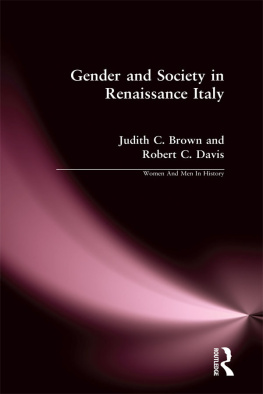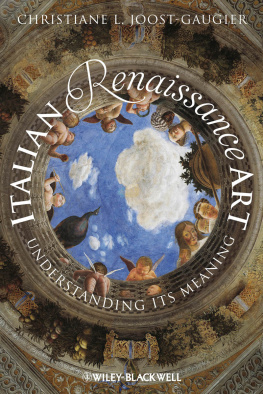The face of medieval Europe was scarred with the ruins of its past. In Rome itself, the Colosseum housed the barbarous Frangipani and their armed retainers, greedy, lawless, destructive ; the Forum provided a quarry for churches and rough pasture for the cattle market, and beneath the broken columns of the temple of Castor and Pollux , the bullocks awaited their slaughter. The Campagna was littered with the crumbling ruins of its aqueducts; the pavements of those splendid Roman roads were narrowed by the returning wilderness. Elsewhere , scraps of walls, the ruins of arena , temple, and triumphal arch, sometimes embedded in the hovels and houses of a town struggling to regain its life or lost forever in the countryside, constantly reminded the people of the Middle Ages of the fleeting life of humankind, of the unknowable nature of Providence . For them, the past was dead, and its relics but morals in stone, a terrible warning of the wickedness that God had punished.
The wealth that was wrung from the soil and the tenuous trade of those dark centuries was poured into the splendid barbaric churches, noble if grotesque, that soared to heaven in violation of all the harmonies of ancient art. Or it served a grimmer purpose, and from it grew the towering fortresses, the embattled towers, the walled cities that were a necessity in a society in which the clang of armor was as common as the church bell .
Yet relics there were, and the miracle is that so much survived the ravages of violence. The barbarian hordes had swept away the thin veneer of Roman culture in Northwestern Europe and broken the powerful web of trade, law, and government that had bound the Mediterranean world in unity. This breach, on which time had worked, was widened by the surge of Islam that swept across and absorbed not only Northern Africa and the islands of Sicily and Sardinia but also the huge peninsula of Spain, and poured over the Pyrenees only to be checked on the plains of France. Under the hammer blows of Vikings, warrior colonists and traders by the sword, Europe and its culture nearly bled to death. Violence, insecurity, and poverty reduced trade and city life to pitiful dimensions. Yet even in the worst of times, groups of peasants spread like a virus through the wastes and forests, colonizing those vast tracts of Europe that the Romans had dominated but never peopled .
Their lives were controlled by a warrior caste that attempted to give them protection, but battened on their labor; or by priests and monks who controlled the ritual of their existence and taught them that life was as fleeting as the crops they har vested . Men of this Western world lived simple, isolated, primitive lives in which pestilence, famine, and war marked the passage of the years.
Yet the past was never quite destroyed, the structure of society never utterly broken. Trade with the great civilizations of Islam and Byzantium transfused a little wealth into the shattered soci ety of the West. More than wealth - ideas , too, could leap across the frontiers of hate and heresy to stimulate the cunning of people . So Byzantium lured them , warriors as well as traders, and so did the challenge of the Muslim world that called the knights to battle and sanctified the blood-crazed warriors of Europe, offer ing them riches in life or glory in death.
This curious society of peasant and priest and warrior that drew its strength from individual people rather than from nations or countries, was held together by the Catholic Church and by feudal law. The secular ideal , often expressed but rarely achieved, was of an ordered, graded society, unchanging and unchangeable, compounded of obligations and rights fixed by law, both written and customary. At all times the majority of men, including the most bloodstained baron, accepted unquestioningly the superior merits of the religious life ; the liturgical worship of God and the contemplation of the spirit, by which humanity subordinated its nature and exorcised its desires, became a social ideal. And like all ideals dreamed of by many, it was attained by few. The institutions were everywhere created, but frequently they served mere mundane ends. For the sake of power and wealth, people forgot their obligations and found it sufficient to expiate their sins in age or defeat. Even for those who genuinely sought the ideal in the most ascetic monastery, the instincts of people broke through and compelled them to draw, to paint, and to sing for the glory of God.
In the darkest decades, there was a force at work - trade - that was inimical to this world of warriors, priests, and peasants. Trade drew Muslim, Jew, and Christian togethe r ; trade fattened towns, sometimes bred them. In so primitive a world, the personalities of kings and popes could lead either to strong government or to social anarchy; peace and good harvests could lift prosperity with outstanding rapidity; war and disease and famine could hold in check all progress, all growth, for a generation. At times it seemed as if the forces of expansion would lift Europe to a higher level of civility than it had known since the decay of Rome; at others that it would vanish and leave nothing but barbarism. In the eleventh century, towns and trade and craftsmanship grew rapidly. An intense interest in ancient learning, particularly in Aristotle, followed; the surging success of the Crusades promised new power and new prosperity. But the prospect faded and disaster followed. The Western Christians savaged the Byzantine Empire; the Muslim world revived under the powerful leadership of the Ottoman Turks; the scourge of the bubonic plague emptied the towns and reduced Europes population by at least a third. A new death rather than a rebirth seemed Europes prospect. Indeed, the dance of death became a threnody of life, haunting the imagination of humanity . Yet in the middle of the fourteenth century, there were forces were working like yeast in the economy and in the spirit of Italy. During the Renaissance, these were to ferment and turn life into a new form, not only in Italy itself but throughout the Western world.
Throughout the Middle Ages, Italy never belonged wholly to Europe. The Romans had thoroughly colonized the land, creating an urban life that neither Goth nor Lombard nor Saracen ever totally destroyed. Feudalism was planted in Italy but never rooted deeply there. Gothic art achieved one or two outstanding successes, but never dominated the Italian imagination. Italy remained a prey of, not a breeding ground for, warriors. During the waves of invasion, there were times when it seemed that Italian society might be destroyed or transmogrified . The hemorrhage of war weakened Italy , emptied its towns, diminished its trade, and enfeebled all institutions save the Church of Rome, whose universality endowed it with some of the authority, if little of the strength, of the Caesars. But always there was trade, there was an urban life. When Belisarius landed in the sixth century at Naples with his Byzantine troops, intent on recapturing Italy for the Eastern Empire, his leading ally was a Syrian businessman, Antiochus. Aistulfs laws for the Lombards, about 750, legislated for merchants. A pair of Venetian traders, in 828, stole the relics of Saint Mark from Alexandria. By 836 , there was at least one merchant, Semplicianus , rich enough to endow a monastery at Milan. Indeed, during these barbarous centuries, Venice was laying the foundations of its future greatness by exploiting the natural advantages that Italy possessed as the link between the primitive world of the North and the sophisticated East. The most valuable traffic was probably in men, women, and children, who were shipped to Alexandria, where there was a ready slave market. Paid in coin, the Venetians then bought luxuries - the silks that the concubines of Charlemagnes court found so ravishing, the great silver dishes that might find their way into the ship-graves of chieftains in the northern seas, the papyrus that the papal Curia needed for its administration. As well as slaves, the Venetians traded the salt from their lagoon for the products of the Lombard plain. Nor was Venice the only mercantile community among Italian cities. Ships from Pisa, Genoa, and Amalfi ventured to the eastern Mediterranean, carrying pilgrims to the Holy Land, trading with the Greeks or the Muslim s or the Jews, creating a spiderweb of commerce. Yet progress was neither steady nor constant. Pirates infested the inland seas, war was endemic, and risks, like profits, were huge. Nor must the amount of trade be exaggerated; often it consisted of nothing more than a peddler plodding dusty roads by the side of the Rhone, carrying his pack laden with eastern marvels to the rural fairs of Champagne.












